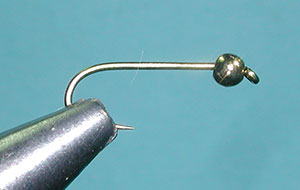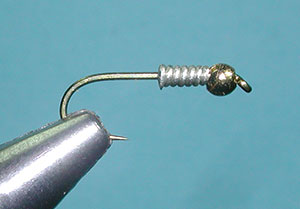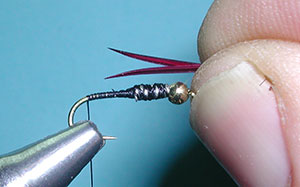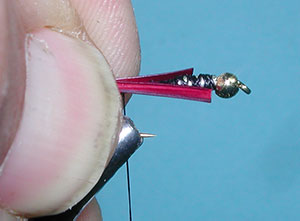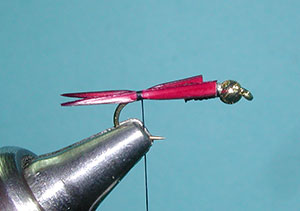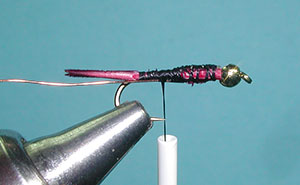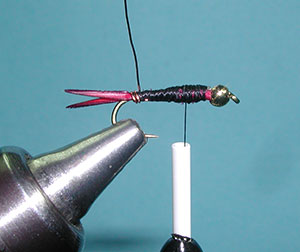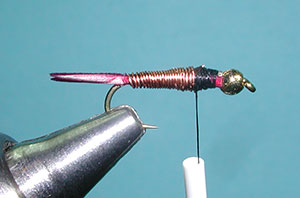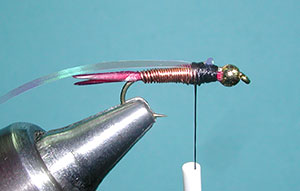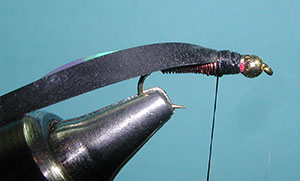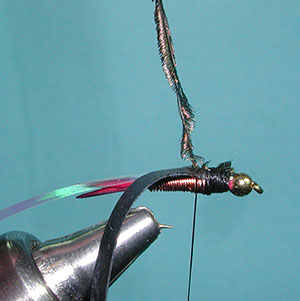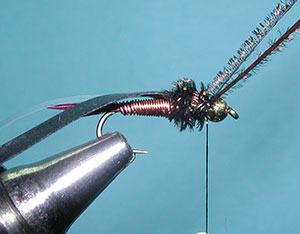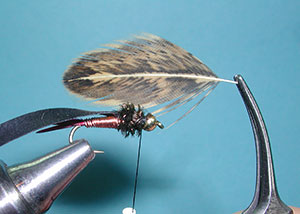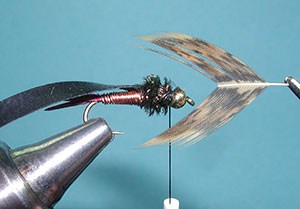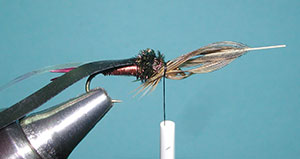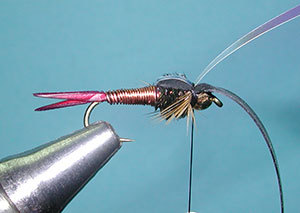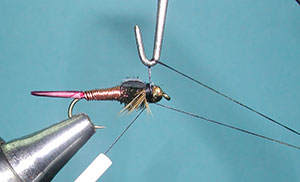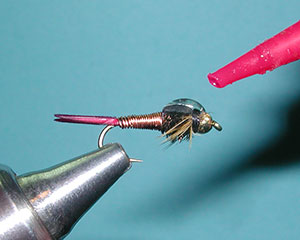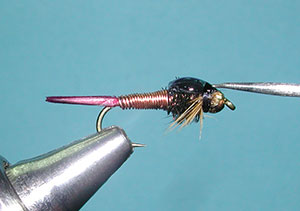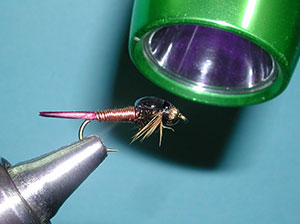Copper John – desire for slim, quick, and flashy
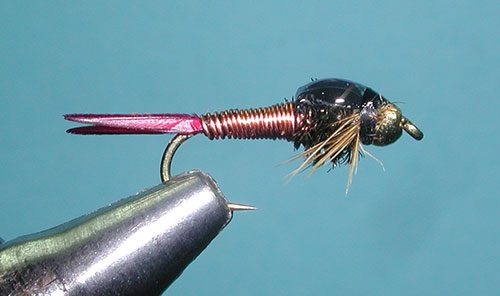
Copper John
Tying Instructions
| Materials
to Order Material, click the link |
|
|---|---|
| Hook | Daiichi 1710 #10-18 |
| Thread | Danville Black 6/0 |
| Head | Gold Bead |
| Weight | 0.020 Leadfree wire |
| Body | Medium Copper wire |
| Tail | Brown Goose Biots |
| Thorax | Peacock Herl |
| Wingcase | Pearl Flashabou and Black Kileys Nymph Skin coated with Loons UV Fly Finish, Thick |
| Legs | Brown Hen Back |
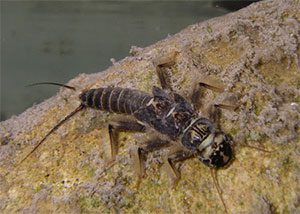
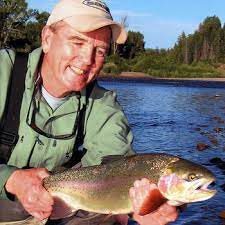
John Barr
Copper John
The Copper John originated from John Barr of Boulder, Colorado. John’s original pattern, in 1996, called for a copper wire abdomen, a tail and legs of Hungarian Partridge, and a thorax of peacock herl with an epoxied Turkey quill wing case. He designed it as an attractor fly to draw attention to a more realistic dropper fly to be used below it. John wanted to achieve a slim, yet heavy, nymph pattern that would allow for a quick descent and have a flashy look to get the trout’s attention. It took John three years to achieve the pattern he desired.
Modifications to the Pattern
Since 1996, the pattern has been modified to have a Goose Biot tail, Brown Hen Back for legs, and Thin Skin for the wingcase material with a Pearl Flashabou over the top of the Thin Skin. The biots and hen back were much more durable than the original materials. The Thin Skin is more durable, but it also accepted only one drop of epoxy, rather than the two drops that were required by the turkey quill. In 2001, Wapsi came out with multiple colors of tarnish-proof wire to give the pattern a wide range of colorations.
Attractor pattern similar to Mayfly or Stonefly Nymph
It is an attractor fly shaped to look like a mayfly or stonefly nymph. Having a broad nymphal shape, it can pass as a caddis larvae with the chartreuse wire abdomen. Larger sizes in black or brown wire can pass for dark stoneflies, and the red patterns can be used for PMD hatches or Yellow Sallies. Black colors in size 18-22 make excellent Baetis or Trico imitations.
His favorite colors are copper, red, chartreuse, and black. John likes to use a Hopper pattern as the floating fly and drops the Copper John pattern below it. His preferred rig set-up is a 7.5 foot 3X mono leader with a heavy butt section to the Hopper fly, next is 2-4 feet of 4X fluorocarbon to the Copper John, and 12 inches of 5X Fluorocarbon to the dropper. Under a strike indicator, John may use the Copper John as the first fly and have two nymphs dropped below it.
Colored Wire
Barr has found that red wire, green, and zebra (Black & Silver) wire variations in sizes 14-18 work very well in stillwater applications when bounced along the bottom below an indicator on a floating line in shoal-type areas. John feels that the fly resembles a chironomid pattern when used in this manner. The fly makes an ideal replacement for any split shot that may be desired for a nymphal rig in sizes 12-14.
Presentation
John indicates that his friend, Doug Ouellette of Reno, NV has a great technique in stillwaters by using two Copper Johns, the heavier one being the point fly, on a 14 foot fluorocarbon leader without an indicator. As the rig drops through the water column using a countdown method, he looks for any unusual movement of the line, as trout will often hit the fly on the drop. Then, when the countdown is complete, he uses quick erratic retrieves of less than 2 inches with 2-4 second pauses. Doug believes that this retrieve resembles the erratic wiggle of an ascending midge and the trout will hit the Copper Johns hard. The Copper John can also be a useful fly for Crappie, Bluegills, and Largemouth Bass.
Select the correct bead size
For a smooth abdomen, build the foundation with as few bumps as possible. Bind the biot tail butts up to the lead wire and trim the excess closely. Bead sizes change according to the hook size. Use 7/64 inch beads for sizes 16-18, 1/8 inch for size 14, and 5/32 inch for size 12. Lead wire should also be used according to hook size. Use .010 for size 18, .015 inch for size 14-16, and .020 inch lead for size 12. Wapsi’s Ultra Wire comes in a wide selection of colors and sizes. The “BR” size is good for hooks #12-14. Use the “SM” size for hooks #16-18.
Variations
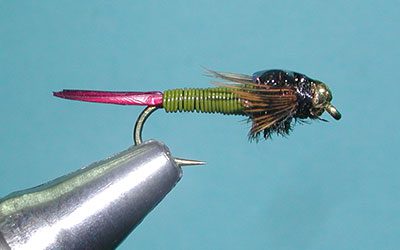
Copper John, Olive
| Hook | Tiemco 5262 #10-18 |
| Thread | Danville Black 6/0 |
| Head | Gold Bead |
| Weight | 0.020 Leadfree wire |
| Body | Medium Olive wire |
| Tail | Brown Goose Biots |
| Thorax | Peacock Herl |
| Wingcase | Pearl Flashabou and Black Kileys Nymph Skin coated with Loons UV Fly Finish, Thick |
| Legs | Brown Hen Back |
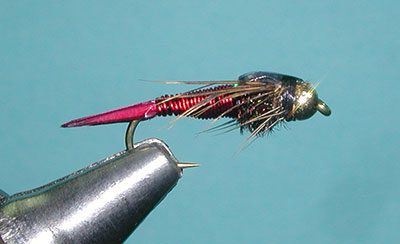
Copper John, Red
| Hook | Tiemco 5262 #10-18 |
| Thread | Danville Black 6/0 |
| Head | Gold Bead |
| Weight | 0.020 Leadfree wire |
| Body | Medium Red wire |
| Tail | Brown Goose Biots |
| Thorax | Peacock Herl |
| Wingcase | Pearl Flashabou and Black Kileys Nymph Skin coated with Loons UV Fly Finish, Thick |
| Legs | Brown Hen Back |
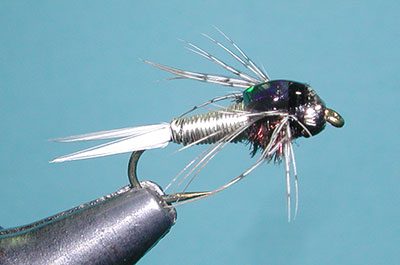
Silver Copper John
| Hook | Tiemco 5262 #10-18 |
| Thread | Danville Black 6/0 |
| Head | Silver Bead |
| Weight | 0.020 Leadfree wire |
| Body | Medium Silver wire |
| Tail | White Goose Biots |
| Thorax | Peacock Herl |
| Wingcase | Pearl Flashabou and Black Kileys Nymph Skin coated with Loons UV Fly Finish, Thick |
| Legs | Gray Hungarian Partridge |
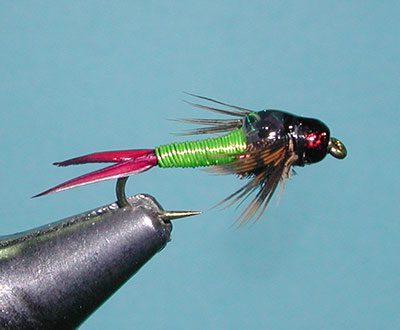
Copper John, Chartreuse
| Hook | Tiemco 5262 #10-18 |
| Thread | Danville Black 6/0 |
| Head | Black Ruby Plummeting Bead |
| Weight | 0.020 Leadfree wire |
| Body | Medium Chartreuse wire |
| Tail | Brown Goose Biots |
| Thorax | Peacock Herl |
| Wingcase | Pearl Flashabou and Black Kileys Nymph Skin coated with Loons UV Fly Finish, Thick |
| Legs | Brown Hen Back |
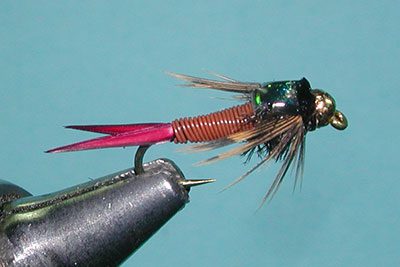
Copper John, Brown
| Hook | Tiemco 5262 #10-18 |
| Thread | Danville Black 6/0 |
| Head | Gold Bead |
| Weight | 0.020 Leadfree wire |
| Body | Medium Brown wire |
| Tail | Brown Goose Biots |
| Thorax | Peacock Herl |
| Wingcase | Pearl Flashabou and Black Kileys Nymph Skin coated with Loons UV Fly Finish, Thick |
| Legs | Brown Hen Back |

